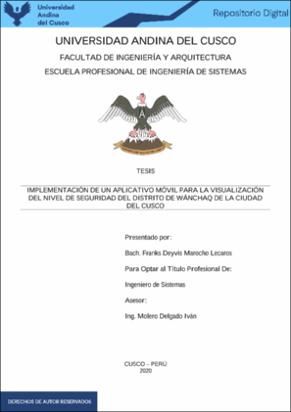| dc.contributor.advisor | Molero Delgado, Iván | |
| dc.contributor.author | Marocho Lecaros, Franks Deyvis | |
| dc.date.accessioned | 2021-06-22T21:24:16Z | |
| dc.date.available | 2021-06-22T21:24:16Z | |
| dc.date.issued | 2020-12-10 | |
| dc.identifier.uri | https://hdl.handle.net/20.500.12557/3931 | |
| dc.description.abstract | La información sobre las zonas más vulnerables del distrito de Wánchaq de la ciudad del
Cusco es mostrada hacia el usuario de forma difícil de obtener y entender, que genera una
pérdida de tiempo e inseguridad por parte de la ciudadanía que reside en el mismo
distrito, no residen allí o son extranjeros.
El objetivo de la presente investigación es desarrollar un aplicativo móvil que muestra la
visualización del nivel de seguridad actual del distrito de Wánchaq de la ciudad del Cusco
así que el problema principal es ¿Cómo desarrollar este aplicativo móvil y que recursos
necesita para que sea implementado?
Para poder desarrollar el aplicativo móvil se utilizó la metodología ágil SCRUM, por la
facilidad que permite esta para la implementación de un software o en este caso un
aplicativo móvil, la interacción con el usuario final tanto con el desarrollador y la
conclusión de una primera versión aceptada.
Los resultados obtenidos fueron los siguientes, qué tecnologías han sido necesarias para
el desarrollo del proyecto, como aplicarla a través de la metodología Scrum, la obtención
de data de zonas vulnerables a través de la Policía y las encuestas para medir en cambio
de percepción del usuario a través del uso de la aplicación, donde se observa el cambio
de mentalidad que se obtiene al conocer una información clara y confiable hacia el
usuario.
Por lo tanto se concluye que la obtención de información del nivel de seguridad a través
de un aplicativo móvil apoya al usuario final que es el ciudadano, a el mejor conocimiento
sobre este , sentirse con más seguridad en el distrito y facilitar un proceso de alguna
denuncia . | es_PE |
| dc.description.abstract | The information on the most vulnerable areas of the Wánchaq district of the city of Cusco
is shown to the user in a way that is difficult to obtain and understand, which generates a
loss of time and insecurity on the part of the citizens residing in the same district, not
reside there or are foreigners.
The objective of this research is to develop a mobile Application that shows the
visualization of the current security level of the Wánchaq district of the city of Cusco, so
the main problem is how to develop this mobile Application and what resources does it
need to be implemented?
In order to develop the mobile Application, the agile SCRUM methodology was used,
due to the ease that this allows for the implementation of a software or in this case a
mobile Application, the interaction with the end user with both the developer and the
conclusion of a first version accepted.
The results obtained were the following, what technologies have been necessary for the
development of the project, how to Apply it through the Scrum methodology, obtaining
data from vulnerable areas through the Police and surveys to measure the change in user
perception Through the use of the Application, where the change in mentality obtained
by knowing clear and reliable information towards the user is observed.
Therefore, it is concluded that obtaining information on the security level through a
mobile Application supports the end user, who is the citizen, to the best knowledge about
it, feel more secure in the district and facilitate a process of any complaint. | en_US |
| dc.description.uri | Tesis | es_PE |
| dc.format | application/pdf | es_PE |
| dc.language.iso | spa | es_PE |
| dc.publisher | Universidad Andina del Cusco | es_PE |
| dc.rights | info:eu-repo/semantics/openAccess | es_PE |
| dc.rights.uri | https://creativecommons.org/licenses/by-nc-nd/2.5/pe/ | es_PE |
| dc.source | Universidad Andina del Cusco | es_PE |
| dc.source | Repositorio Institucional UAC | es_PE |
| dc.subject | Metodología Scrum | es_PE |
| dc.subject | Aplicativo móvil | es_PE |
| dc.subject | Seguridad | es_PE |
| dc.subject | Usuarios | es_PE |
| dc.title | Implementación de un aplicativo móvil para la visualización del nivel de seguridad del distrito de Wánchaq de la ciudad del Cusco | es_PE |
| dc.type | info:eu-repo/semantics/bachelorThesis | es_PE |
| thesis.degree.name | Ingeniero de Sistemas | es_PE |
| thesis.degree.grantor | Universidad Andina del Cusco. Facultad de Ingeniería y Arquitectura | es_PE |
| thesis.degree.level | Titulo Profesional | es_PE |
| thesis.degree.discipline | Ingeniería de Sistemas | es_PE |
| dc.publisher.country | PE | es_PE |
| dc.subject.ocde | https://purl.org/pe-repo/ocde/ford#2.02.03 | en_US |
| renati.advisor.dni | 25705893 | |
| renati.advisor.orcid | https://orcid.org/0000-0003-0568-0562 | en_US |
| renati.author.dni | 73209326 | |
| renati.discipline | 612076 | |
| renati.juror | Acurio Gutierrez, Maria Isabel | |
| renati.juror | Bernales Guzman, Yessenia | |
| renati.juror | Holguin Herrera, Melisa Betys | |
| renati.juror | Espetia Huamanga, Hugo | |
| renati.level | https://purl.org/pe-repo/renati/level#tituloProfesional | es_PE |
| renati.type | https://purl.org/pe-repo/renati/type#tesis | es_PE |


